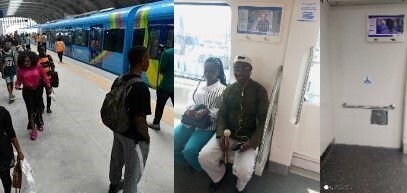The Lagos light rail seems the most accessible public infrastructure with little government ineptitude. Lagosians’ attitude now creates a barrier.
By Elijah Olusegun
The Lagos Metropolitan Area Transport Authority (LAMATA) has no excuse to not tick off all the right boxes, including accessibility, on launching its Light Blue Rail weeks ago. The state's Special People Law (Section 18) expects no less.
After about 13 years of design, construction, and evaluation, the contractor Chinese Civil Engineering Construction Corporation eventually delivered: a built rail system (first phase), and four-car trains by China Railway Rolling Stock Company (CRRC). All blasted off in early September.
Among the first thousands of everyday Nigerians to hop on the train after it launched was Kayode Afolabi from Alimosho.
He and his colleague Stella also had every reason to mark up their October 20 commute as smooth. They lucked into a divisional police officer heading to their destination on a bus at Oshodi. They found themselves in safe hands. Until he took them to the ticketing section of the Mile 2 Blue Rail Station.
“Everything here is blue. The train, the station, the uniform, the card, the roof.” The police officer was describing the terminal.
The big honcho there saw Kayode and his colleague goose-stepping in behind their lead, and went mad as a hare.
“Whoever you are, you have to pay and buy a card.”
He shouted when they hadn’t even asked him a question.
“We have our money to pay,” Kayode responded. “We just want to make an inquiry. Stop shouting!”
The slanging match ended, and a lady attendant came over. They were back in good hands once again.
Kayode’s raft of questions didn’t bug Mary (pseudonym to protect her identity). From the ticketing section, she and one other staffer walked him through buying and recharging of the Cowrie card; she helped him and his colleague tap—use the digital card to swipe a sensor—in to the boarding section. She also walked them down three flights of stairs, 15 steps each, and on to the platform.
“Only the reflective jackets are yellow,” she said to Kayode crosschecking the DPO’s earlier description.
His I-should-have-known-it moment ought to have ended the question-and-answer session.
She finally helped them into the cabin, set for a ride to Marina, the first station, en route from the Mile 2 station, the last on that corridor, for now.
“Mind the gap between the train and the platform as you step in.”
The announcement, in English and Yoruba, rang out loud. It ought to.
But Kayode had folded his cane that could stick in the small gap. His trousers bags didn’t sag. Nor did his shirt sleeves hang roomy enough to snag at anything. And Mary still held him and his partner.
“I could feel the AC immediately we entered,” he told ER. “The floor is level. No steps. Plain. It was cool, men!”
He asked again about standing room, hand rails, restrooms, and canteens on board, and other questions. She answered all, except the last two, in the positive: the entire train can haul 250,000 Lagosians daily, 800 at once. With 200 more standing. Two trains in service for now, the third as back-up. They are all powered by an independent electricity supply.
“You can eat outside the station, and use the station’s restrooms when the train stops at the next station,” she said.
The public address system in his cabin was not loud enough, but Kayode could still hear the announcer telling him of the destination, the next stop over, and other information.
Before departure, he asked Mary to help take their pictures. And she did.
The Marina experience—tapping out and tapping in, recharging, and others—was similar. They only descended into the ticketing area to recharge, and tap in again, without any incident. The platform and the rail are all up a bridge that snakes over the lagoon from Marina to Iganmu.
Mary again waited to welcome the couple on their return trip to Mile 2.
“LAMATA trained us to be helpful and respectful to commuters,” she told ER, before she shuttered up for further questions.
Mary’s nature probably shone through in her own case.
No matter how ableist, a first timer can’t help getting mixed up going through the motion at the stations. And for PWDs, it’s a whole different story, starting meters away to the train stations.
At the Mile 2 terminal, wheelchair users have to skirt the station, get to its other side to use the ramp to access the ticketing floor upstairs. One of the Mile 2 attendants told ER.
The ramp at Marina stands a long way off the entry point for people coming in from the descent of the bridge at CMS. But the distance—a kind of gap—is nothing compared to what it will take a wheelchair user to navigate the entire terrain. Crowds of cloth sellers and food hawkers mushroom all over the beginning of the walkway. The one leading to the ramp at the Mile 2 station is not particularly crowded. But a culvert here, and another there have been broken or out of place, creating another gap. To get to the station in the first place is hard not only for wheelchair users; it’s also risky for white cane users.
The terminal entrance itself opens high up the bridge. Only one person (at a time) can step in to that cavern of a multistory building. Lights, signs, graphics, and directions blink and glow blue. Attendants stand about to assist. Ticketing, balance checking, recharging and all that.
From there passengers tap in, and barrel across the hall to take anyone of a lift, an escalator and a staircase that leads up (or down) to the boarding platform.
A ticket seller didn’t follow his training when ER visited the Alaba station. Answering questions about recharging and balance checking was too much bother for him. But two female attendants quickly stepped in, filled the gap, and lightened the experience. One of them had to join the train to help clarify the enquiry at the Mile 2 station.
LAMATA has yet to respond to the question on whether their customer experience training included a disability-specific module. Especially about stereotyping.
And there are questions people other than Kayode could have also asked—like why the lifts labelled accessible weren’t working.
ER also asked LAMATA.
“Somebody got stuck in it, and they had to seal it for now,” a staffer at the Marina station said.
As of October, none of the lifts across the corridor worked. And Mary wouldn’t reveal how many people like Kayode and others she had helped on board so far with the current level of accessibility in her station.
But, either by leaps or bounds, passengers that find their way to the platform are almost home and dry.
The CRRC train, to some extent, complies with modern accessibility standards: a floor in each cabin at the same level as the platform; spaces for wheelchairs; wall screens; graphics; and others. And the gap between the platform and the train is no barrier to a wheelchair rolling in unaided.
A staffer in one of the cabins told ER a user can perch in a designated place marked for the mobility device. But the spot is not in every cabin, the mark indicates.
Displaying on a wall video screen are testimonials from satisfied commuters, each station name, and text of audio sliding by at the bottom. A warning, in text, audio, and graphics, indicates smoking, eating, carrying inflammable things attract a fine of N25, 000 each.
There may still be complaints of inaccessibility. But such griping may not necessarily be about the train—or its terminals. The larger built environment and culture in which the light blue rail (alongside the red and five other types later) operates may be the hitch.
LAMATA has to answer whose responsibility it is to mind these gaps—particularly those that lie beyond its terminals.







